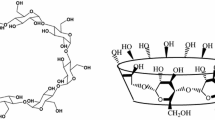Summary
The reduced viscosity of poly(ethylene glycol) (PEG) is increased in solutions of (2-hydroxypropyl)-α-cyclodextrin (HPACD) significantly more than in the solution of (2-hydroxypropyl)-β-cyclodextrin (HPBCD) in agreement with the fact that a crystalline complex of PEG is formed in solutions of natural α-cyclodextrin but not in solutions of natural β-cyclodextrin. In analogy with that, the viscometry indicates formation of a complex between HPBCD with poly(vinyl alcohol) because the reduced viscosity is markedly increased in solutions of HPBCD but only slightly in solutions of HPACD. On the other hand, the increase in the viscosity of poly(N-vinylpyrrolidone) (PVP) was identical in HPACD and HPBCD solutions; therefore, the viscometry did not provide support for the suggested side-chain complexation between PVP and cyclodextrins.
Similar content being viewed by others
Author information
Authors and Affiliations
Additional information
Received: 7 May 1998/Accepted: 10 June 1998
Rights and permissions
About this article
Cite this article
Horský, J. Viscometric detection of polymer inclusion complexes. Polymer Bulletin 41, 215–221 (1998). https://doi.org/10.1007/s002890050354
Issue Date:
DOI: https://doi.org/10.1007/s002890050354




